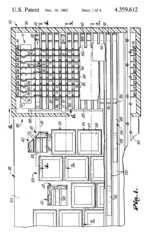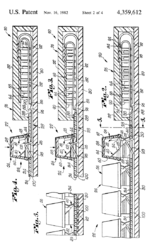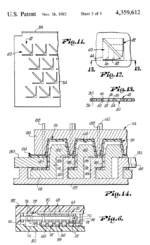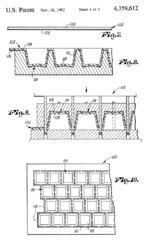Universal keyboard and method of producing same
The universal keyboard and method of producing same is a low cost, minimum depth, high speed full stroke keyboard with N-key rollover protection and tactile feedback mounted on synthetic resin flaps designed with independent snap motion of the keys. The patent was filed on September 24, 1980 and issued on November 16, 1982. Some handheld, rubber dome, and membrane-based keyboards are manufactured under this patent.
Contents
Description
Universal keyboard and method of producing same
- Inventor: Craig E. Rooney
- Patent number: 4359612
- Filing date: September 24, 1980
- Issue date: November 16, 1982
Summary
A low cost, minimum depth, high speed full stroke keyboard with N-key rollover protection and tactile feedback mounted on synthetic resin flaps designed with independent snap motion of the keys. The keys are mounted on synthetic resin flaps designed in such a way that the flaps collapse after depressing the keys which in turn engage a resilient U-shaped element attached to encoding posts. As a result, the element disengages and snaps back to the original position without further movement of the keys. [1]
Abstract
The preferred key array in accordance with the present invention is formed of synthetic resin material and includes an integral synthetic resin base sheet cut to present a plurality of upstanding, individual flaps, with respective key tops secured to the flaps. When force is applied to the keys, the supporting flaps collapse. After the release of the keys, the resilience of the flaps along with the resilience of the underlying shifting strip cooperatively return the key to its position.
Background of the invention
The present industry standard for key tops on reliable equipment is double injection molded synthetic resin key tops. In this form the key tops are first molded in one color of synthetic resin and an inner shell space is allowed for a second color injection that results in key legending being injected completely through the outer key shell. This process is inherently expensive in many ways. For example it requires two complete injection runs for manufacture of the keyboard using extremely expensive molding equipment which cannot be altered except at great expense. The double molding operation also results in a key top that is of substantial thickness and consumes a considerable amount of material.
The most expensive and reliable keyboards on the market today are so called Hall effect keyboards. In these units key depression closes a switch which is magnetically sensed and only a breakdown in the mechanics of the switch cannister or chassis can effect reliability of such a device. However Hall effect keyboards are inherently very expensive by virtue of the many components required.
The present invention in large measure solves the problems outlined above and provides a greatly improved keyboard which in preferred forms is manufactured almost entirely from low cost synthetic resin materials for ease of fabrication and cost reduction. The keyboard includes a plurality of separate depressible keys means for developing a keyboard output corresponding to depression of particular keys and structure operably coupling the keys and the output means. The coupling structure associated with the keyboard hereof preferably includes an elongated resilient element associated with each key respectively along with means for shifting the element in response to depression of the associated key and means for disengaging the element in its shifted condition and allowing the same to snap back toward its original rest position independently of any subsequent movement of the key and related structure. The output means includes apparatus such as a microswitch which senses the shifting movement of the resilient element and in this way develops an electric signal.
Craig E. Rooney
Universal keyboard and method of producing same
Referenced by
- US patent 4948281, Arend Werner, "Keyboard protected against vandalism and spill", issued 14 August 1990, assigned to International Business Machines Corporation
- US patent 5358344, Kenny R. Spence, "Keyboard with full-travel, sefl-leveling switches", issued 25 October 1994, assigned to Key Tronic Corporation
- US patent 5569889, Michael A. Friedhofer, "Key assembly and keyboard comprising key retraction and stabilization means.", issued 29 October 1996, assigned to Ericsson GE Mobile Communications Inc.
Images
References
- ↑ US patent 4359612, Craig E. Rooney, "Universal keyboard and method of producing same", issued 16 November 1982, assigned to Engineering Research Applications, Inc.




